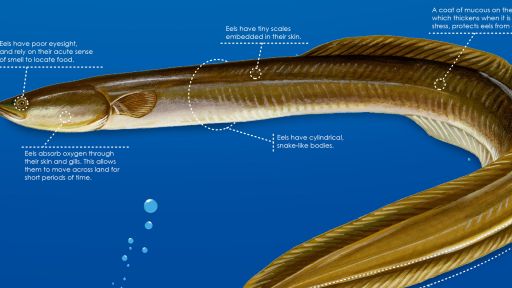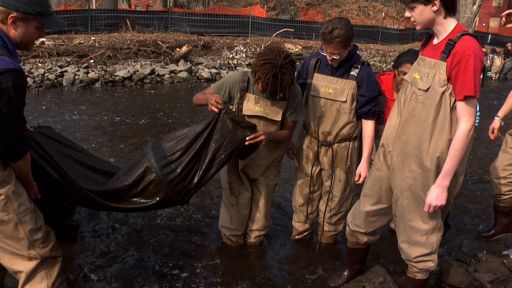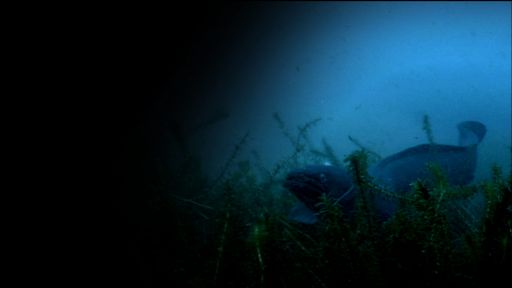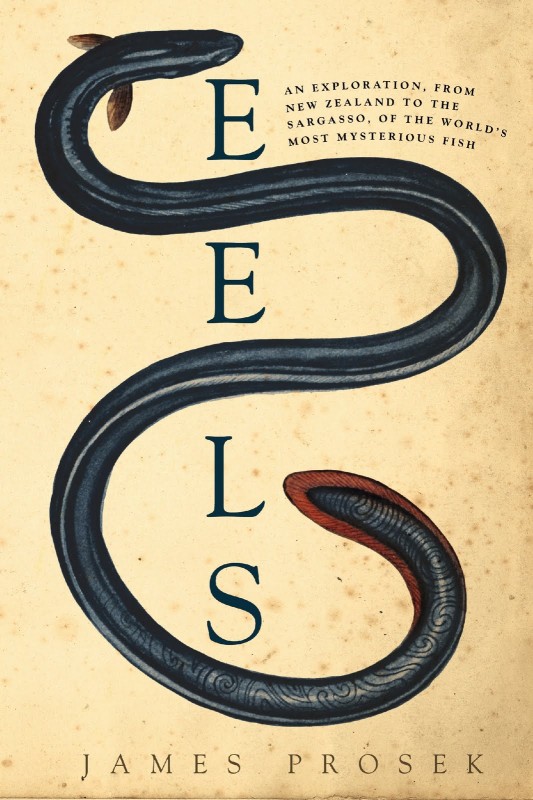 Described as something of “an underwater Audubon,” James Prosek has always had a particular fondness for marine life—the trout, billfish, and other fishes that are part of the fresh and saltwater ecosystems covering much of the globe. He has dedicated years to studying and writing about these water worlds and the diverse creatures which inhabit them. Prosek’s latest adventure centers around the eel, a migratory fish (it’s not a snake) that continues to leave scientists puzzled. In his book, Eels: An Exploration, From New Zealand to the Sargasso, of the World’s Most Mysterious Fish, Prosek travels in an effort to unravel the mystery of the eel; to better know its habits and life cycle (to-date no one has witnessed eels spawning in the wild), as well as explore the creature’s complex and varied relationships with humans. Read an excerpt:
Described as something of “an underwater Audubon,” James Prosek has always had a particular fondness for marine life—the trout, billfish, and other fishes that are part of the fresh and saltwater ecosystems covering much of the globe. He has dedicated years to studying and writing about these water worlds and the diverse creatures which inhabit them. Prosek’s latest adventure centers around the eel, a migratory fish (it’s not a snake) that continues to leave scientists puzzled. In his book, Eels: An Exploration, From New Zealand to the Sargasso, of the World’s Most Mysterious Fish, Prosek travels in an effort to unravel the mystery of the eel; to better know its habits and life cycle (to-date no one has witnessed eels spawning in the wild), as well as explore the creature’s complex and varied relationships with humans. Read an excerpt:
Eels: An Exploration, From New Zealand to the Sargasso,
of the World’s Most Mysterious Fish
by James Prosek
Conjecture about what an eel is exactly, or where its place is in the tree of life, has racked the brains of more than a few naturalists. Its limbless elongated body led some to believe it was related to the snake. The Greek naturalist and poet Oppian wrote in the second century A.D.: “Nothing more is known, than what people repeat about the loves of Roman eels and snakes. Some say that they pair, that, full of eagerness, drunk with desire, the Roman eel comes out of the sea to go and meet her mate.” As late as 1833 Jerome V. C. Smith wrote in his Natural History of the Fishes of Massachusetts: “On the whole, we view the eel in the light of a water-serpent, being the connecting link between purely aquatic and amphibious reptiles.” The eel, however, is a fish, though it is a fish like no other.
The freshwater eel, of the genus Anguilla, evolved more than fifty million years ago, giving rise to fifteen separate species. Most migratory fish, such as salmon and shad, are anadromous, spawning in freshwater and living their adult lives in salt water. The freshwater eel is one of the few fishes that does the opposite, spawning in the sea and spending its adulthood in lakes, rivers, and estuaries—a life history known as catadromy (in Greek ana- means “up” and cata- means “down,” that prefixes suggesting the direction the fish migrates to reproduce). But among caradromous fishes, the eel is the only one that travels to the depths of the oceans so far offshore.
“Salmon,” Mike Miller, an eel scientist, told me, “can imprint on a river system. They are born in the river system, they go out in the ocean, and they come back to the same river—it’s not that bloody hard to do. In the case of the eel, you’re born in the open ocean. You can’t see anything around you except blue water. It’s just blue water until they come to the coastal areas, where they first enter estuaries and streams at random. And then, ten to thirty years later when they leave the river, they have to swim all the way out to the same place in the ocean again. And how do they do that?”
The American and European freshwater eels (Anguilla rostrata and Anguilla anguilla) emerge from eggs suspended in the ocean—specifically, the western part of a subtropical gyre in the North Atlantic somewhere east of Bermuda called the Sargasso Sea. The only reason scientists know this is that baby eels in their larval stage, called leptocephali, have been found drifting near the surface of the ocean thousands of miles from any short. No one has ever been able to find a spawning adult or witness a freshwater eel spawning in the wild. For eel scientists, solving the mystery of eel reproduction remains a kind of holy grail.
Wherever eels are born, they’re relentless in their effort to return to their oceanic womb. I can tell you this from personal experience because I’ve tried to keep them in a home aquarium. The morning after the first night of my attempt, I found eels slithering around the floor of my kitchen and living room. After securing a metal screen over the tank with heavy stones, I was able to contain them, but soon they were rubbing themselves raw against the screen. Then one died trying to escape via the filter outflow. When I screened the outflow, they banged their heads against the glass until they had what appeared to be seizures and died. That’s when I stopped trying to keep eels.
Eels are wondrous in their ability to move. They’re often found in lakes, ponds, and postholes with no visible connection to the sea, leaving the inquisitive shaking their heads. On wet nights, eels are known to cross over land from a pond to a river, or over an obstruction, by the thousands, using each other’s moist bodies as a bridge.Young eels can climb moss-covered vertical walls, forming a braid with their bodies. Farmers in Normandy say that eels will leave rivers on spring nights and find their way to vegetable patches to feed on peas.
The yearly journeys of millions of adult eels make from rivers to oceans must be among the greatest unseen migrations of any creature on the planet. In the course of these journeys, which span thousands of miles, eels face a long list of dangers: hydroelectric dams, river diversions, pollution, disease, predation (by striped bass, beluga whales, cormorants, among others), fishing by humans, and changes in ocean currents or temperature structure due to global warming, which may confound eels during their migrations.
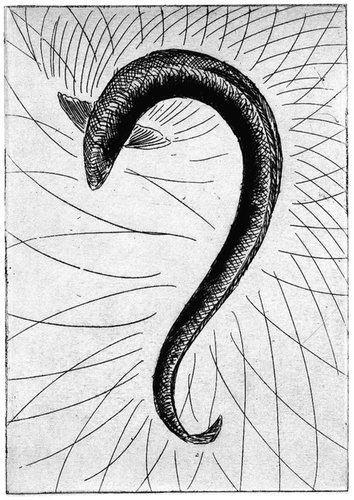
From Aristotle through Pliny, Walton, and Linnaeus, great naturalists through time have put forward various theories as to how eels make new eels—that the young emerged from the mud (Aristotle); that eels are bred from a particular dew that falls in the months of May and June (Walton); that they multiplied by rubbing themselves against rocks (Pliny)l that they were viviparous, bearing live young rather than laying eggs (Linnaeus). One problem was that no one could identify sperm or eggs in eels. Over a forty-year period in the late 1700s, at the famous eel fishery at Comacchio, Italy, the biologist Spallanzani calculated that more than 152 million adult migratory eels had been caught and cleaned, not one of which was found to be pregnant. No one could say for sure whether eels even had gender, because no one could identify their reproductive organs.
In the late nineteenth century, a young medical student named Sigmund Freud was assigned by his professor Carol Claus to investigate what had been postulated to be the testes of the male eel. During several months at the Zoological Experimental Station in Trieste, Italy, Freud dissected more than four hundred eels, looking for loops of white matter festooned in the body cavity. His 1877 paper on eels, “Observations on the Form and the Fine Structure of Looped Organs of the Eel, Organs Considered as Testes,” was Freud’s first published work. One can’t help but wonder if the time he spent that summer in his twentieth year dissecting eels played some role in the development of his later psychosexual theories.” Needless to say, the testes of the eel would not be confirmed until 1897, when a sexually mature male eel was caught in the Straits of Messina between mainland Italy and the island of Sicily.
The larval stage of the eel bears little resemblance to the adult#&8212;it is a tiny, transparent creature with a thin head, a body shaped like a willow leaf, and outward-pointing teeth. The larvae of freshwater eels were originally thought to be that of a separate genus of fish, first described as Leptocephalus breverostris in 1856 by the German naturalist Kaup after a specimen from the Mediterranean Sea (the common name for eel larvae today, leptocephali, remains as a relic of this misnomer.) Then in 1896 two Italian biologists, Grassi and Calandruccio, watched a Leptocephalus breverostris metamorphose in a tank into an eel#&8212;the most convincing evidence to support the theory that freshwater eels were born in salt water. Still, though some speculated that eels spawned in the Mediterranean, no one had yet dreamed that freshwater eels from Europe hatched in the middle of the Atlantic Ocean.
In 1904, James Schmidt, a young Danish fisheries biologist, got a job abroad the Thor, a Danish research vessel, studying the breeding habits of food fishes such as cod and herring. One day in the summer of that year, a tiny fish larva showed up in one of their find-mesh trawls, west of the Faroe Islands in the Atlantic Ocean. Based on the number of vertebrae, 115, and the hypural bones at the end of teh vertebral column, Schmidt identified the larva as that of the European eel, Anguilla anguilla, the first to be recognized as such outside of the Mediterranean Sea.
A year before, Schmidt had made an auspicious betrothal to the heiress to the Carlsberg Brewery, A Danish company that had donated generously to marine research. Outfitted with schooners capable of ocean crossings, towing fine-mesh nets and catching hundreds of larvae, he was able to show that the farther from the European coast he went, the smaller the eel larvae became. After almost two decades of cruising the Atlantic, Schmidt was able to assert that both the American and European eels spawned somewhere in the southwestern part of the Atlantic—the Sargossa Sea. “No other instance is known among fishes of a species requiring a quarter of the circumference of the globe to complete its life history,” Schmidt wrote in 1923. “Larval migrations of such extent and duration…are altogether unique in the animal kingdom.”
Schmidt and his colleagues went on to search for the spawning areas of other freshwater eel species in the Indo-Pacific region, but with limited success. No other discoveries of anguillid eel-spawning areas came until 1991, when an expedition led by Katsumi Tsukamoto of the Ocean Research Institute in Tokyo found the spawning grounds of the Japanese eel. Japanese scientists had searched unsuccessfully for the spawning area of Anguilla japonica for six decades. But on this particular newmoon night in the Pacific Ocean, in the Philippine Sea to the west of Guam, Tsukamoto and the other scientists on board netted the smallest larvae of that species that had ever been collected and finally determined the location of the spawning area of the Japanese freshwater eel. Still, they had not captured any adults.
Mike Miller, then a graduate student from the University of Maine, Orono, who was on the fateful expedition, described what it was like to look for spawning eels in the open ocean. “You could be fifty meters away and not find anything,” he said. “It’s an issue of scale—the ocean is huge. To get where eels are spawning, it’s statistically very low probability. Almost impossible. You’d have to be very lucky.” It didn’t help that every previous year in which they’d made a cruise to look for the adults they’d run afoul of the elements. “I can’t remember a single eel cruise when there hasn’t been a typhoon that caused us to change course,” Miller added. It’s almost like Poseidon is trying to keep the eels’ secret.”
That’s the greatest beauty I find in eels: the idea of a creature whose very beginnings can elude humans, and the potential that idea holds for our imaginations.

Like the people I met in my travels, I get a good feeling from eels. The nights and early mornings I’ve spent with them during the fall migration have pulsed with energy and light. Standing in an eel fisherman’s river weir in the cool September dark, watching the vein-like ropes of fish fill his womb of wood and stone, I’ve come to believe the Maori yarns about encounters they’ve had with the water guardians.
We allow ourselves to believe that nature can be explained. In the process we confine nature to those explanations. The eels, through their simplicity of form, their preference for darkness, and their grace of movement in the opposite direction of every other fish, have helped me to see things for which there is no easy classification things that can’t be quantified or solved, and get to the essence of experience. They have been my way back.
 Artist, writer, activist, and Yale graduate James Prosek made his authorial debut at nineteen years of age with Trout: an Illustrated History (Alfred A. Knopf, 1996), which featured seventy of his watercolor paintings of the trout of North America. Prosek has shown his paintings with the Gerald Peters Gallery, New York and Santa Fe; Meredith Long Gallery, Houston; as well as with Wajahat/Ingrao, New York, the d.u.m.b.o. arts center, Brooklyn, Reynolds Gallery, Richmond, VA and the Aldrich Contemporary Art Museum in Ridgefield, CT. He has upcoming shows at the National Academy of Sciences, DC, the Academy of Natural Sciences in Philadelphia, the Addison Gallery of American Art in Andover, MA and the New Britain Museum of American Art in New Britain, CT. Prosek has written for The New York Times and National Geographic Magazine and won a Peabody Award in 2003 for his documentary about traveling through England in the footsteps of Izaak Walton, the seventeenth-century author of The Compleat Angler. He co-founded a conservation initiative called World Trout in 2004 with Yvon Chouinard, the owner of Patagonia clothing company, which raises money for cold water habitat conservation through the sale of T-shirts featuring trout paintings. Prosek is a curatorial affiliate of the Peabody Museum of Natural History at Yale, and a member of the board of the Yale Institute for Biospheric Studies.
Artist, writer, activist, and Yale graduate James Prosek made his authorial debut at nineteen years of age with Trout: an Illustrated History (Alfred A. Knopf, 1996), which featured seventy of his watercolor paintings of the trout of North America. Prosek has shown his paintings with the Gerald Peters Gallery, New York and Santa Fe; Meredith Long Gallery, Houston; as well as with Wajahat/Ingrao, New York, the d.u.m.b.o. arts center, Brooklyn, Reynolds Gallery, Richmond, VA and the Aldrich Contemporary Art Museum in Ridgefield, CT. He has upcoming shows at the National Academy of Sciences, DC, the Academy of Natural Sciences in Philadelphia, the Addison Gallery of American Art in Andover, MA and the New Britain Museum of American Art in New Britain, CT. Prosek has written for The New York Times and National Geographic Magazine and won a Peabody Award in 2003 for his documentary about traveling through England in the footsteps of Izaak Walton, the seventeenth-century author of The Compleat Angler. He co-founded a conservation initiative called World Trout in 2004 with Yvon Chouinard, the owner of Patagonia clothing company, which raises money for cold water habitat conservation through the sale of T-shirts featuring trout paintings. Prosek is a curatorial affiliate of the Peabody Museum of Natural History at Yale, and a member of the board of the Yale Institute for Biospheric Studies.

